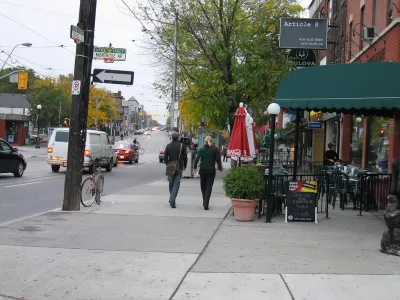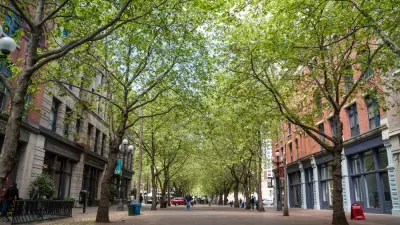Researchers at the University of New Mexico created a sidewalk design using materials that would reduce heat absorption and require fewer materials than traditional concrete sidewalks.

Traditional concrete sidewalks "absorb heat, occasionally buckling because of the pressure from heated expansion; and can even reflect heat, causing 'heat islands' in urban areas." Hope Muñoz and Rachel Whitt report on an innovation that could replace concrete with cooler, more environmentally friendly materials. Research students at the University of New Mexico have "designed a sidewalk built using recycled and less energy- and carbon-intensive materials," which is also much thinner than the average four-inch sidewalk.
After looking at historic sidewalk construction, researcher Patience Raby said "[i]t seems there was not good explanation for the use of standard concrete mixes in sidewalks or even for the fact that they’re usually four inches deep." According to a Federal Highway Administration report, "Atmospheric heat islands can affect communities by increasing summertime peak energy demand, electrical grid reliability, air conditioning costs, air pollution and GHG emissions, heat-related illness and death, and water quality." The new design reduces heat and the amount of materials needed for its construction. "The researchers fabricated three slabs to compare their thermal output, emissivity, and energy balance."
"In the future, the team would like to design 3D printed concrete slabs and those which are thin fiber reinforced with voids. These slabs would later be tested for heat storage potential."
FULL STORY: UNM researchers explore cool and renewable sidewalks

Alabama: Trump Terminates Settlements for Black Communities Harmed By Raw Sewage
Trump deemed the landmark civil rights agreement “illegal DEI and environmental justice policy.”

Planetizen Federal Action Tracker
A weekly monitor of how Trump’s orders and actions are impacting planners and planning in America.

How Atlanta Built 7,000 Housing Units in 3 Years
The city’s comprehensive, neighborhood-focused housing strategy focuses on identifying properties and land that can be repurposed for housing and encouraging development in underserved neighborhoods.

In Both Crashes and Crime, Public Transportation is Far Safer than Driving
Contrary to popular assumptions, public transportation has far lower crash and crime rates than automobile travel. For safer communities, improve and encourage transit travel.

Report: Zoning Reforms Should Complement Nashville’s Ambitious Transit Plan
Without reform, restrictive zoning codes will limit the impact of the city’s planned transit expansion and could exclude some of the residents who depend on transit the most.

Judge Orders Release of Frozen IRA, IIJA Funding
The decision is a victory for environmental groups who charged that freezing funds for critical infrastructure and disaster response programs caused “real and irreparable harm” to communities.
Urban Design for Planners 1: Software Tools
This six-course series explores essential urban design concepts using open source software and equips planners with the tools they need to participate fully in the urban design process.
Planning for Universal Design
Learn the tools for implementing Universal Design in planning regulations.
Jessamine County Fiscal Court
Caltrans
Institute for Housing and Urban Development Studies (IHS)
City of Grandview
Harvard GSD Executive Education
Toledo-Lucas County Plan Commissions
Salt Lake City
NYU Wagner Graduate School of Public Service





























